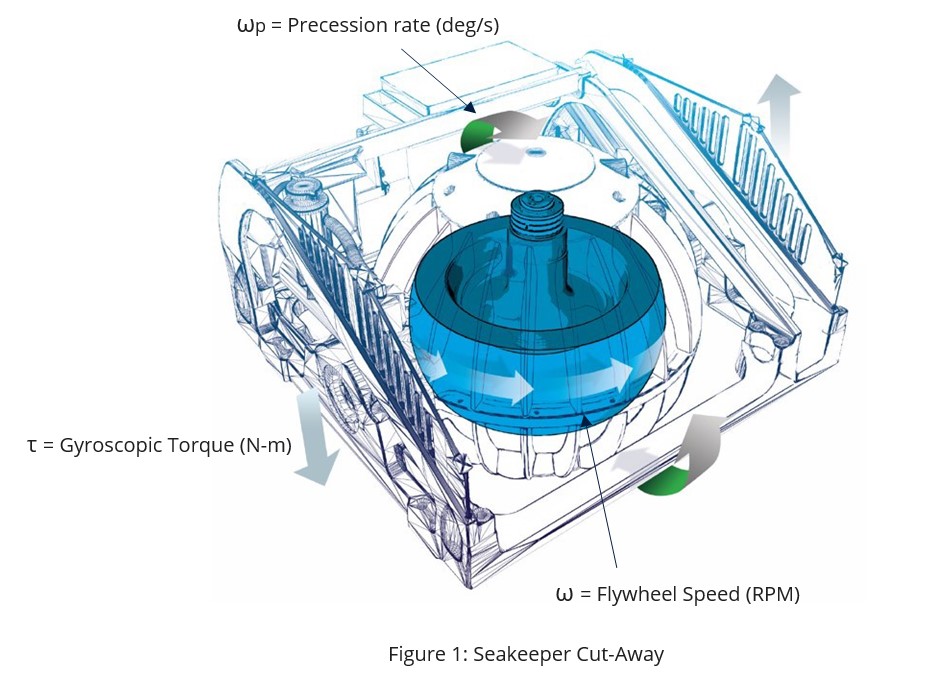ANGULAR MOMENTUM VS. TORQUE

ANGULAR MOMENTUM
For gyroscopic stabilizers, angular momentum (measured in Newton-meter-seconds, or N-m-s) is the equivalent of horsepower for an engine and is the accepted measure of rating gyroscopic output. The angular momentum determines the total amount of torque available over time. Therefore, greater angular momentum indicates greater levels of roll reduction potential for gyroscopic stabilizers. Angular momentum (L) is the product of the fundamental gyroscope parameters: moment of inertia of the flywheel (I) – which is a product of flywheel mass and radius squared in kg*m2 – and angular velocity of the flywheel ( ) – which is the speed of rotation in rpm.
GYROSCOPIC TORQUE
The faster a gyroscope precesses or rotates about its gimbal axis, the higher its peak torque value. However, this faster precession speed significantly reduces the amount of time the peak torque can be applied. The wave energy that creates boat roll is not instantaneous; it is applied to the boat in a sinusoidal manner with wave periods of 2.0 to 10+ seconds. Because of this sinusoidal application, the most effective use of a gyroscope’s angular momentum is to spread the torque over a period of time that matches the wave period. Gyroscopic torque (τ) is the product of angular momentum (L) and gyro precession rate ( p) in degrees per second.
GYRO STABILIZER PERFORMANCE
Representing gyroscope rating on maximum torque output is misleading as it does not account for the wave period or the natural roll period of a vessel. This is significant because increases in wave period or natural roll period can cause a significant decrease in peak torque values. Table 1, shows the effect of natural roll period on the maximum torque output for a Seakeeper 6 with a fixed angular momentum of 6000 N-m-s.
Table 1: Peak Gyroscopic Torque (2.5 – 4.0 Second Roll Period)
| NATURAL ROLL PERIOD (S) |
MAX PRECESSION RATE (DEG/S) |
MOMENTUM |
PEAK TORQUE (N-M) |
| 2.50 | 150 | 6000 | 15,690 |
| 3.00 | 126 | 6000 | 13,159 |
| 3.50 | 108 | 6000 | 11,280 |
| 4.00 | 94 | 6000 | 9870 |
Boat natural roll periods can vary from 2.3 seconds on small boats to as much as 7.0 seconds on mega yachts. In order to eliminate boat roll, a gyroscope must be able to provide stabilizing torque throughout this entire roll cycle, an output which is measured in angular momentum. Using the example above for a gyroscope rated at 6,000 N-m-s of angular momentum, quoting peak torque values above 15,690 N-m is misleading as boats in this size range (~40 to 49 ft.) rarely exhibit a natural roll period below 2.5 seconds.
SEAKEEPER PERFORMANCE
Seakeeper has studied various boat operating conditions both theoretically, using motion simulations, and experimentally on more than 1,000 sea trials. Every aspect of Seakeeper’s design has been engineered to maximize efficiency in eliminating boat roll. The key innovations of the Seakeeper system — the vacuum chamber, high speed bearings, electronic active control, and patented liquid cooling system — are state-of-the-art and represent the level of sophistication that consumers expect. Because of these unique innovations, Seakeeper has set the standard for stabilization.


